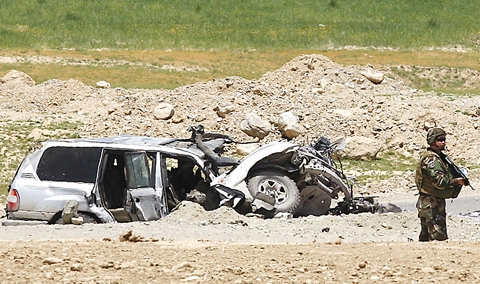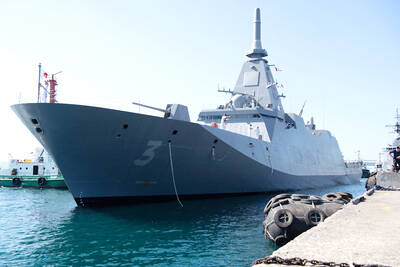The US military said yesterday at least 20 civilians and 60 insurgents may have died in a disputed US-Taliban clash earlier this month, refuting the Afghan government’s assertion that 140 civilians were killed.
In Kabul, meanwhile, a US service member was killed in a roadside bomb attack, the military said.
Preliminary findings could not conclusively determine the number of people killed during the May 4 to May 5 battle in Bala Buluk district of western Farah Province, the US military said in a statement.

PHOTO: AP
The clash has soured already tense relations between the US military and the Afghan government. In an attempt to soothe these relations, America’s top envoy in Afghanistan joined Afghan President Hamid Karzai on Tuesday in extending their condolences to the families of the victims near the site of the battle.
The US military statement said its aircraft destroyed several rural buildings where insurgents were regrouping after the fight, in which some 300 militants had participated.
Colonel Greg Julian, the chief US military spokesman, said eight buildings were targeted, and 13 missiles were fired from US military aircraft during the battle.
“The investigation team estimates that 60 to 65 Taliban extremists were killed in these engagements, while at least 20 to 30 civilians may have been killed during the fighting,” the statement said.
“A review of the physical evidence is inconclusive in determining the exact number of civilian and insurgent casualties,” it said.
Karzai has long pleaded with the US to minimize civilian deaths during its military operations and not use airstrikes in villages.
He said civilian deaths at the hands of foreign troops erode support for the fight against the Taliban, who have made a comeback after they were ousted in the US-led invasion in 2001.
On Tuesday, Karzai urged the US to distinguish between villagers and militants.
“All those people who wear a turban and have local clothes are not Taliban,” Karzai told the gathering. US troops “should cut down bombardment on them,” he said.
Afghans blame US airstrikes for the deaths and destruction in two villages in Bala Buluk, but it is unclear exactly how many people died there and under what circumstances.
Eight more Afghan civilians are believed to have been killed when NATO-led troops under attack in southern Afghanistan called in an air strike, the alliance said yesterday.
Soldiers from the International Security Assistance Force (ISAF) came under attack from about 25 insurgents in the province of Helmand on Tuesday and were forced to call in the strike, ISAF said in a statement.
“Tragically, it is believed that eight civilians were killed as a result of the air strike,” it said.
Meanwhile, the Afghan army killed 25 Taliban insurgents, including two commanders, in an operation to wrest back an area of southern Afghanistan from rebel control, a general said yesterday.
Heavy fighting has dogged the insurgent stronghold and opium-producing area in Helmand Province for days, with security forces saying that they killed 25 Taliban there nearly there a week ago.
Afghan troops backed by US-led forces went on the offensive in the Marja area, about 40km from the provincial capital Lashkar Gah, Helmand army commander General Mohaidin Ghori said.

Eleven people, including a former minister, were arrested in Serbia on Friday over a train station disaster in which 16 people died. The concrete canopy of the newly renovated station in the northern city of Novi Sad collapsed on Nov. 1, 2024 in a disaster widely blamed on corruption and poor oversight. It sparked a wave of student-led protests and led to the resignation of then-Serbian prime minister Milos Vucevic and the fall of his government. The public prosecutor’s office in Novi Sad opened an investigation into the accident and deaths. In February, the public prosecutor’s office for organized crime opened another probe into

RISING RACISM: A Japanese group called on China to assure safety in the country, while the Chinese embassy in Tokyo urged action against a ‘surge in xenophobia’ A Japanese woman living in China was attacked and injured by a man in a subway station in Suzhou, China, Japanese media said, hours after two Chinese men were seriously injured in violence in Tokyo. The attacks on Thursday raised concern about xenophobic sentiment in China and Japan that have been blamed for assaults in both countries. It was the third attack involving Japanese living in China since last year. In the two previous cases in China, Chinese authorities have insisted they were isolated incidents. Japanese broadcaster NHK did not identify the woman injured in Suzhou by name, but, citing the Japanese

YELLOW SHIRTS: Many protesters were associated with pro-royalist groups that had previously supported the ouster of Paetongtarn’s father, Thaksin, in 2006 Protesters rallied on Saturday in the Thai capital to demand the resignation of court-suspended Thai Prime Minister Paetongtarn Shinawatra and in support of the armed forces following a violent border dispute with Cambodia that killed more than three dozen people and displaced more than 260,000. Gathered at Bangkok’s Victory Monument despite soaring temperatures, many sang patriotic songs and listened to speeches denouncing Paetongtarn and her father, former Thai prime minister Thaksin Shinawatra, and voiced their backing of the country’s army, which has always retained substantial power in the Southeast Asian country. Police said there were about 2,000 protesters by mid-afternoon, although

MOGAMI-CLASS FRIGATES: The deal is a ‘big step toward elevating national security cooperation with Australia, which is our special strategic partner,’ a Japanese official said Australia is to upgrade its navy with 11 Mogami-class frigates built by Japan’s Mitsubishi Heavy Industries, Australian Minister for Defence Richard Marles said yesterday. Billed as Japan’s biggest defense export deal since World War II, Australia is to pay US$6 billion over the next 10 years to acquire the fleet of stealth frigates. Australia is in the midst of a major military restructure, bolstering its navy with long-range firepower in an effort to deter China. It is striving to expand its fleet of major warships from 11 to 26 over the next decade. “This is clearly the biggest defense-industry agreement that has ever